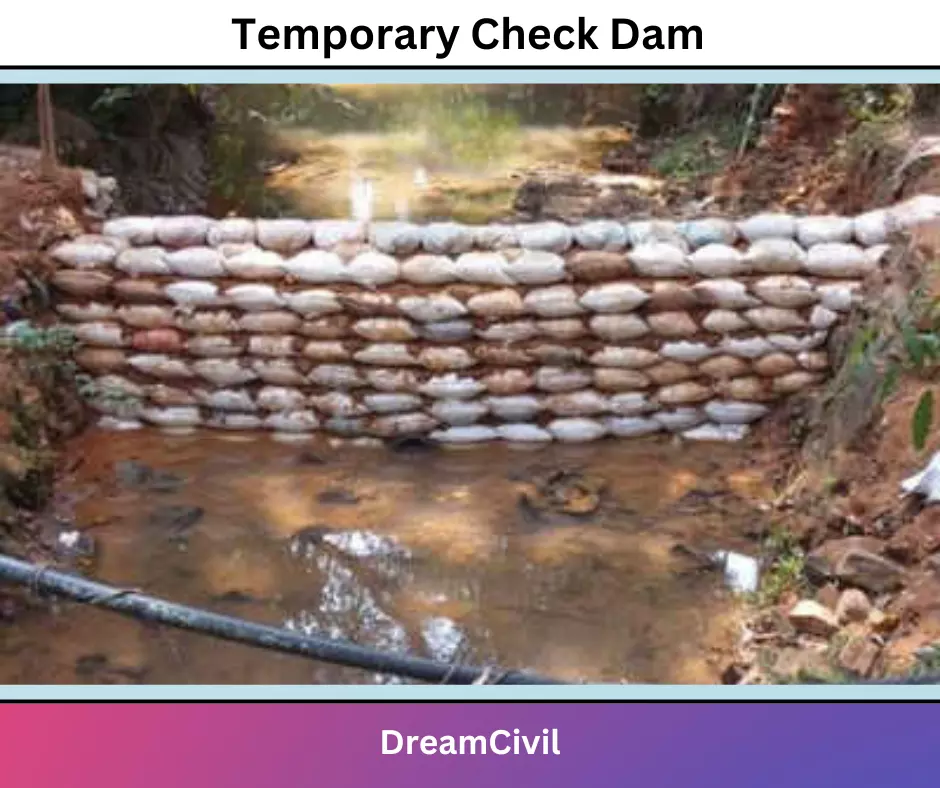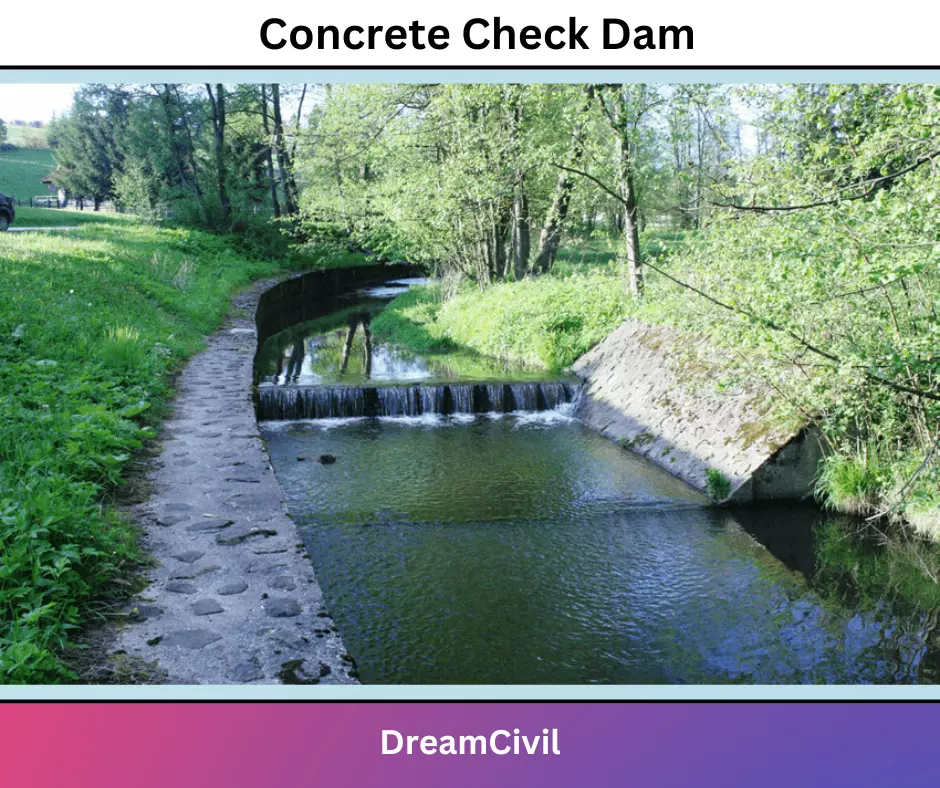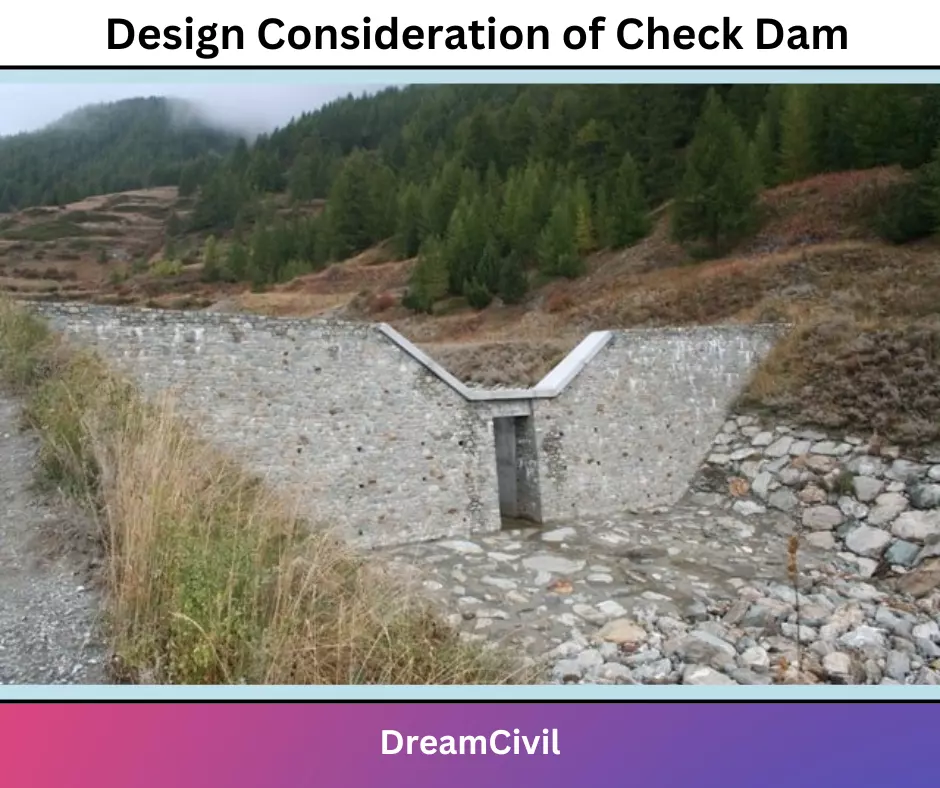Table of Contents
| Summary: A check dam is a linear structure constructed perpendicular to concentrated flows across the waterway to control erosion by reducing the velocity of the flow. ✔ Check dam retains flood water and traps sediment. It is best to use when the drainage area is 10 acres or less. ✔ Construction of the check dam is relatively inexpensive and easy. ✔ Check dam materials may include fiber logs (e.g., wattles), rock, sandbags, triangular sediment dikes, concrete, steel, prefabricated systems, or other materials. ✔ The check dam consists of an embankment and spillway. Some check dam consists of the only embankment. ✔ Straw/hay bales and silt fences should not be used for check dam applications, as they are not intended for concentrated flow areas. ✔ At the beginning of construction, a water body would be formed behind the check dam; gradually, the water body will be filled with sediment deposits. The area formed by the deposit is usually used as farmland because it plays an essential role in grain production in that region. ✔ Check dam is generally used in concentrated flow areas but not in-stream or channel. It can be the permanent or temporary barrier that prevents erosion and promotes sedimentation by slowing flow velocity. |
1. Purpose
The primary purpose of a check dam is to reduce the velocity of the flow to control erosion, not to collect sediment, although sediment collection is an added benefit.
2. Types of Check Dam
i. Based on Purpose
a. Temporary Check Dam
These check dams are constructed for a limited time.
Generally, rocks, logs, and sandbags are utilized to construct temporary check dams.

b. Permanent Check Dam
These dams are constructed permanently.
These dams are generally constructed using concrete, steel, rock, or a composite of two or more materials.

ii. Based on Materials Used
a. Concrete Check Dam

b. Rock Check Dam

c. Rubber Check Dam

d. Fiber Log Check Dam

e. Silt Dike Check Dam

f. Sand Bag Check Dam

3. Functions of Check Dam
A check dam is pre-designed and constructed to meet the following concept:-
1. To reduce the velocity of the water.
2. Raise the bed level and reduce the slopes in a gully by silting up and trapping the silt.
3. Support the unstable side slopes.
4. Promote water percolation in the soil and conserve water for plant growth and the stability of banks.
4. Design Consideration of Check Dam
Design consideration includes the following points:-

1. Site selection
b. The spillway has to be large enough with sufficient freeboard to take the expected maximum runoff. (concrete mortared rock dam must not exceed 8 m in height, whereas the log crib dam must not exceed 2 m. The spacing of a dam for 2 m height in a 20-degree channel will be 12 m.)
c. It should be made at a straight and firm stream bed. It should not be made on a curve and junction of gullies or streams.
d. The foundation of the check dams should rest on base rock.
e. The height of the structure also restricts the selection of the site. If the elevation difference between the 2 sides is too high, 1 or more sides must be selected in between so that structural height will be limited.
2. Spacing
The spacing of check dams should be so placed that the line joining the top of the lower check dam and the bottom of the successive upper check dam gives the gradient.
This gradient will give a non-erosive velocity of flow. This gradient is known as a compensation gradient.
The compensation gradient is taken as 3 to 5% of the slope for general practice. The horizontal distance between successive check dams is given by:
b=h*100/(So-Se)
where,
h=Height of check dam up to the notch
So=Existing bed slope in percentage
Se=Establishing slope of the bed in percentage
3. Number
The number of check dams required is determined from the following formula:
number of check dams =(a-b)/H
where,
b=Se*d’/100
d’=horizontal distance between first and last dam
H=average height
5. Design – Example
We have provided this design example in PDF Format for your ease. Download it and grab the knowledge.
| Download Example | Download |
6. Hydrological Aspect
a. Runoff estimate
The rational formula is the most commonly used method for forecasting runoff.
The peak rate of runoff is calculated by using the following rational formula;
Q=CIA/360
Where,
Q=Rate of runoff
C=Catchment coefficient or the coefficient of runoff
I=Intensity of runoff
A=Catchment area
7. Advantages of Check Dam
Some advantages of this dam are:
a. It provides an irrigation facility.
b. It reduces flow velocity and helps in the protection of river banks.
c. Economical than other dam types.
d. It is simple to construct the check dam. So, no requirement for advanced machines and technologies.
e. It helps in flood & erosion control.
f. It facilitates the production of electricity on a small scale.
8. Disadvantages of Check Dam
Some disadvantages of this dam are:
a. It causes a rise in the groundwater table.
b. Affects aquatic life.
c. It has a limited life span and strength.
d. Depending on the type of check dam installed, removal may be costly.
e. Requirement of maintenance mainly after heavy rainfall.
| Read Also: Earthen Dam |
